Shortwave Radio - Learning The
Basics
CONTENTS
What is a shortwave radio?
On the technical side, a shortwave radio is a receiver that
can receive radio transmission on frequencies between 3 and 30 MHz. The main
characteristic of these frequencies is their ability to "propagate" for long
distances, making possible such world-wide communications as international broadcasting
and coordination of long-distance shipping.
Why would I want/need one?
The primary reasons people own and use shortwave radios are
personal enjoyment and keeping up with local emergency channels. From a social point
of view, shortwave radio is a method of enabling world-wide transmission of information
and opinion, and a way to find out information and opinions from around the world. Many
countries broadcast to the world in English, making it easy to find out what a given
country's position is on those things that it finds important. Shortwave radio can
also provide a way to eavesdrop on the everyday workings of international politics and
commerce. You can hear news and other programs from a wide range of sources, and you
can get emergency information by listening to amateur radio broadcasts including Single
Side Band (SSB) transmissions. You also have Longwave (LW) band for Ship-to-Shore calls.
FM and Medium Wave (MW) are commonly called AM.
What do I need to know to use
one?
Shortwave listening is a hobby with thousands of
participants worldwide, and all you need to know to begin is how to tune a radio. There
are no special knowledge or skill requirements; however, as you gain experience and
develop special listening techniques, your listening enjoyment increases accordingly.
These skills include keeping up on local and non-local issues which affect the broadcast,
knowing how to troubleshoot your radio and antenna installation and maintenance. The
basic equipment you would need is a radio and a list of frequencies. In most cases, you
can receive many stations using the antenna that comes with the radio; however, to receive
more distant stations, you can use an external long-wire antenna.
What types are available?
Shortwave radios are distinguished from each other by
tuning method, size, and frequency range. A comparison of the shortwave radios we carry is
given below:
| RadioShack Shortwave Radios |
Features |
| Model DX-396 (Cat. No. 20-226) 
|
Tuning: Digital Size: 4 3/4 x 7 1/4 x 1 3/8"
Antenna: Rod Only
Frequency Range:
AM, FM, FM Stereo
SW (AM mode)
120, 90, 75, 60, 49, 41, 31, 25, 21, 19, 16, 13 Meters
User's Manual Available
On-line |
| Model DX-402 (Cat. No. 20-230) 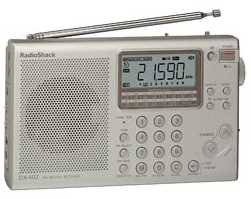
|
Tuning: Digital Size: 5 x 8 1/2 x 1 3/8"
Antenna: Rod Antenna and External Antenna Jack
Frequency Range:
LW, AM, FM Stereo
SW (continuous, AM & SSB modes)
User's Manual Available
On-line |
| Model DX-398 (Cat. No. 20-228) 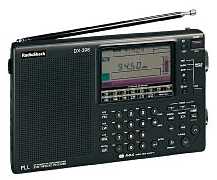
|
Tuning: Digital Size: 5 x 8 1/4 x 1 1/2"
Antenna: Rod Antenna and External Antenna Jack
Frequency Range:
LW, AM, FM, FM Stereo
SW (continuous 50 kHz - 29.999 MHz, AM & SSB/CW modes)
User's Manual Available
On-line |
What accessories can I use to
improve my listening enjoyment?
There are several things you can get which will affect your
listening enjoyment:
Antennas pull in more distant and/or
weaker stations
Headphones allow you to focus on the transmissions without outside
interference
External Speakers allow you to improve on the built-in speakers
Listening Guides and Reference Books give you information on stations,
frequencies and using your equipment
The last and most important "accessory" is Experience.
Time spent working with your shortwave unit teaches you the skills and
information to get the most out of shortwave listening, such as the best times in your
area for reception and how to best use your equipment.
Antennas
Headphones
Full-size Monaural Headset
Cat. No. 20-282This closed-cup headset is ideal for
scanner or shortwave listening, particularly in noisy areas. It is great for air shows,
car races, events, because the comfortable earcups seal out noise. It has a 1/8" plug
and comes with a 1/4" adapter.
User's Manual Available On-line |
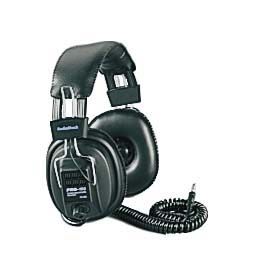 |
Lightweight Monaural Headphones
Cat. No. 20-210This is a comfortable,
lightweight monaural headset for your shortwave radio. It has a 1/8" plug and comes
with a 1/4" adapter.
User's Manual Available
On-line |
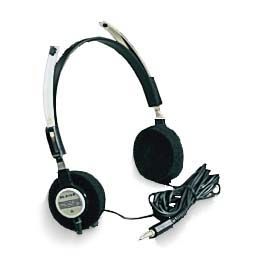 |
External Speakers
Budget PC
Speakers (Pair)
Cat. No. 40-1404Compact magnetically shielded
stereo speakers include speaker wire and brackets for mounting. Extended bass adds
exciting depth to multimedia programs and games.
Size of each speaker: 5-1/16x3-7/16x3-5/8".
Add 4 "AA" batteries in each speaker. Can use an
AC adapter Cat. #273-1770, or a DC adapter Cat. #273-1815.
User's
Manual Available On-line |
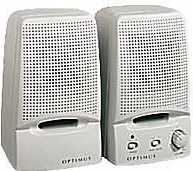 |
Shielded
2-Way Speakers
Cat. No. 40-1405Ported enclosures and Bass Boost
for solid sound. New 3D surround effect adds real depth to stereo image. 5 watts per
channel. 150-20,000Hz. 4" woofer/2" tweeter. AC powered.
User's Manual Available On-line |
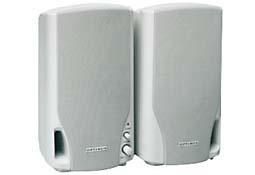 |
2-Way
Amplified Speaker System (Pair)
Cat. No. 40-1406Amplified speakers with Extended
Bass AMX-19. 2-way speakers with surround sound add another dimension to your system's
sound. Extended Bass for deep, rich lows. Magnetically shielded for interference-free use
near a monitor. 4" woofer, 2" tweeter. Frequency response 150-20,000Hz. 7"
high. Requires 8 "C" batteries or adapter: AC #273-1779/M, DC #270-1534. |
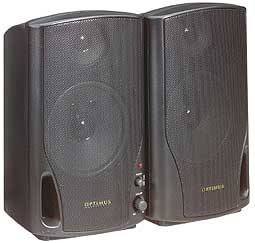 |
Amplified
2–1/4 " PC Speakers (Pair)
Cat. No. 40-1407Magnetically shielded.
Bass/treble boost controls. 2–1/4" full-range speaker. 500-12,000Hz frequency
response. Small (4x2-1/2 x2-7/8") size - easy to take along. Requires 4 "C"
batteries or DC adapter.
User's Manual Available On-line[51984.htm - MISSING] |
 |
Amplified 4" Full-Range
Speakers (Pair)
Cat. No. 40-1408Magnetically shielded. 4"
full-range speaker. Bass and treble boost controls. 100-12,000Hz frequency response.
6–1/2×4–7/16×4–7/8 ". Black finish. Requires 4 "C"
batteries or adapter: AC #273-1770 or DC #273-1815.
User's Manual Available On-line |
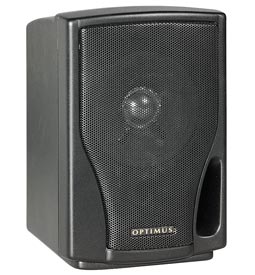 |
Shielded
Mini-Speakers
Cat. No. 40-1409This pair of
magnetically-shielded, compact amplified stereo speakers add super sound to your PC
monitor, TV, stereo or portable CD player. Convenient 3-way power-plays on home AC or car
DC with optional adapters, or 8 "C" batteries, optional. The separate bass,
treble and volume knobs give you control the sound quality. The sleek, contemporary design
for a timeless look that complements any décor.
- 3 1/2" speaker
- 160-12,000Hz frequency response
- 3 1/2 ft. cord
- 1/8" mini phono plug
|
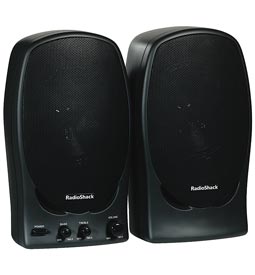 |
Listening Guides
Antennas - Selection and Installation
Cat. No. 62-1083Here's everything you need to
know in order to choose and install the best possible antenna system. It discusses
antennas for TV, FM, CB, cellular telephone, satellite and shortwave. Deals with the
problem of TV and FM reception in fringe areas. Clear meaningful illustrations and
easy-to-read text. 112 pages. |
 |
The New Shortwave
Propagation Handbook
Cat. No. 920-0073By George Jacobs. This book is a
necessary tool for radio amateurs, shortwave listeners and radio communicators of all
types. Discover the most productive uses of the radio spectrum. |
 |
What are the shortwave bands and/or
frequencies?
A band is a group of frequencies. Sometimes, bands are
grouped according to their wavelengths, in meters. The tuning locations of a station can
be expressed as a frequency (kHz or MHz) or a wavelength (meters). Amateur radio
operators generally refer to the frequencies they operate on using the frequency's
wavelength. For example, the 19-meter band refers to the range of frequencies with waves
about 19 meters long. You can use the following equations to convert kHz, MHz, and
meters.
- To convert MHz to kHz, multiply by 1,000. For example:
9.62 MHz x 1000 = 9620 kHz
- To convert kHz to MHz, divide by 1,000. For example:
2780 kHz divided by 1000 = 2.780 MHz
- To convert MHz to meters, divide 300 by the number of MHz.
For example:
300 divided by 7.1 MHz = 42.25 meters
- To convert meters to MHz, divide 300 by the number of
meters. For example:
300 divided by 42.25 meters = 7.1 MHz
Certain bands are set aside for specific purposes; these
are called the band allocations and are listed below:
AM Band
FM Band
Aircraft Frequencies
Amateur Radio Frequencies
International Commercial Frequencies
Longwave Band
Ship and Coastal Station Frequencies
Time Standard Frequencies
AM Band
The AM band is between 520 kHz and 1720 kHz and is used for
commercial radio broadcasts.
FM Band
The FM band is between 87.5 MHz and 108 MHz and is used for
commercial radio broadcasts.
Aircraft Frequencies
Aircraft on international routes sometimes use SW. Most
transmissions are in SSB, although you can still hear some MW transmissions. Here are some
bands where you might hear aircraft communications.
4,650-4,750 kHz
6,545-6,765 kHz
8,815-9,040 kHz
11,175-11,400 kHz
13,200-13,360 kHz
15,010-15,100 kHz
17,900-18,030 kHz
Amateur Radio Frequencies
Amateur radio operators in the US operate mostly in LSB
(Lower Side Band) mode. Morse code operators are generally found in the lower areas of
each band. The amateur radio operators with the most advanced classification are found in
the upper areas of each band.
Tuning to the amateur radio frequencies can be interesting
and helpful, because amateur radio operators often broadcast emergency information when
other means of communication break down. Portions of these bands are set aside for
continuous wave (CW) Morse code communication or for single sideband (SSB) voice
communications, as shown below.
160 meters:
1,800 - 2,000 kHz: SSB |
80 meters:
3,500 - 3.800 kHz: CW
3,800 - 4,000 kHz: SSB |
40 meters:
7,000 - 7,150 kHz: CW
7,150 - 7,300 kHz: SSB |
30 meters:
10,100 - 10,150 kHZ |
20 meters:
14,000 - 14,200 kHz: CW
14,200 - 14,350 kHz: SSB |
17 meters:
18,068 - 18,168 kHz |
15 meters:
21,000 - 21,250 kHz: CW
21,250 - 21,450 kHz: SSB |
12 meters:
21,990 - 24,890 kHz |
10 meters:
25,000 - 28,500 kHz: CW
28,500 - 29,700 kHz: SSB |
Note: These ranges are not precisely observed everywhere in
the world.
International Commercial
Frequencies
International commercial broadcasts are found in the
following shortwave bands. Programs (often in English) usually contain news, commentaries,
music, and special features reflecting the culture of the broadcasting country. Reception
for this range is best between 6:00 PM and midnight (your time).
| 120 meters * |
2.300 MHz to 2.495 MHz |
| 90 meters * |
3.200 MHz to 3.400 MHz |
| 75 meters * |
3.850 MHz to 4.000 MHz |
| 60 meters * |
4.750 MHz to 5.060 MHz |
| 49 meters |
5.900 MHz to 6.200 MHz |
| 41 meters ** |
7.100 MHz to 7.350 MHz |
| 31 meters |
9.400 MHz to 9.990 MHz |
| 25 meters |
11.600 MHz to 12.100 MHz |
| 21 meters |
13.500 MHz to 13.870 MHz |
| 19 meters |
15.100 MHz to 15.800 MHz |
| 16 meters |
17.480 MHz to 17.900 MHz |
| 13 meters |
21.450 MHz to 21.750 MHz |
| 11 meters |
25.600 MHz to 26.100 MHz |
* These bands are reserved for stations in topical areas.
** Interference is heavy in the 41m band (7.100-7.300 MHz) because amateur radio operators
and international stations share this range.
Longwave Band
The 150-519 kHz range is known as the longwave band. Most
stations in this range serve as beacons for aircraft and marine navigation by continuously
transmitting their call letters. Reception for this range is best between 6:00 PM and
midnight (your time).
Some ships also use this range, wit 500 kHz set aside as an
international distress and emergency station.
Most stations in this range use CW (Morse code), although
some use AM voice transmission for weather broadcasts.
Ship and Coastal Station
Frequencies
Most transmissions from ships and coastal stations are in
SSB and CW. You can hear these transmissions in the following bands:
2,000-2,300 kHz
4,063-4,139 kHz
4,361-4,438 kHz
8,195-8,181 kHz
12,330-12,420 kHz
13,107-13,200 kHz
16,460-16,565 kHz
* The Coast Guard and small boats use this band, with 2,182
kHz set aside as the international distress and emergency channel.
Time Standard Frequencies
The following frequencies announces the exact time of day
at specified intervals.
WWV in Fort Collins, Colorado
2,500 kHz
5,000 kHz
10,000 kHz
15,000 kHz
20,000 kHz
CHU in Canada
7,335 kHz
VGN in Australia
4,500 and 12,000 kHz
How do I know where to tune for
specific stations?
The following list contains some of the more frequently
heard stations. All stations broadcast in English unless otherwise specified. You can hear
these stations throughout North America. However, reception varies bases on the season,
time of day, and a number of other conditions. This information is subject to change at
any time without notice.
| kHz |
Station |
Location |
Remarks |
| 3,223 |
Radio SR |
Swaziland |
|
| 3,265 |
Radio Mozambique |
Maputo, Mozambique |
|
| 3,300 |
Radio Cultural |
Guatemala City, Guatemala |
Religious Programs |
| 3,380 |
Radio Iris |
Esmeraldas, Ecuador |
Program in Spanish |
| 3,285 |
FR3 |
Cayenne, French Guiana |
Programs in French |
| 3,396 |
Radio Kaduna |
Kaduna, Nigeria |
|
| 4,750 |
Radio Bertoua |
Bertoua, Cameroon |
|
| 4,755 |
Imo Regional Radio |
Imo, Nigeria |
|
| 4,777 |
Radio/TV Gabon |
Libreville, Gabon |
Programs in French |
| 4,795 |
Radio Nueva America |
La Paz, Bolivia |
Programs in Spanish |
| 4,820 |
Radio Paz y Bien |
Ambala, Ecuador |
Programs in Spanish |
| 4,832 |
Radio Reloj |
San Jose, Costa Rica |
Programs in Spanish |
| 4,855 |
Radio Clube do Para |
Belem, Brazil |
Programs in Portugese |
| 4,890 |
National Broadcasting Commission |
Papua New Guinea |
|
| 4,915 |
Voice Kenya |
Nairobi, Kenya |
|
| 4,920 |
Australian Broadcasting Commission |
Brisbane, Australia |
|
| 4,945 |
Radio Colosal |
Neiva, Colombia |
Programs in Spanish |
| 4,965 |
Radio Santa Fe |
Bogota, Colombia |
Programs in Spanish |
| 4,980 |
Ecos del Torbes |
San Cristobal, Venezuela |
Programs in Spanish |
| 5,020 |
Solomon Islands Broadcasting Service |
Honiara, Solomon Islands |
|
| 5,057 |
Radio Gjirokaster |
Gjirokaster, Albania |
Programs in Albanian |
| 5,950 |
Guyana Broadcasting Service |
Georgetown, Guyana |
|
| 5,954 |
Radio Casino |
Puerto Limon, Costa Rica |
|
| 5,960 |
Radio Canada International |
Montreal, Canada |
|
| 5,980 |
Radio RSA |
Johannesburg, South Africa |
|
| 6,005 |
CFCX |
Montreal, Canada |
|
| 6,025 |
Radio Malaysia Kuala |
Lumpur, Malaysia |
Programs in Chinese |
| 6,045 |
Radio Australia |
Lyndhurst, Australia |
|
| 6,055 |
Nihon Shortwave Broadcasting Company |
Tokyo, Japan |
Programs in Japanese |
| 6,060 |
Radio Nacional |
Buenos Aires, Argentina |
Programs in Spanish |
| 6,075 |
Radio Sutatenza |
Bogota, Colombia |
Programs in Spanish |
| 6,090 |
Radio Luxembourg |
Ville Louvigny,Luxembourg |
|
| 6,095 |
Polskie Radio |
Warsaw, Poland |
|
| 6,105 |
Radio New Zealand |
Wellington, New Zealand |
|
| 7,140 |
Trans World Radio |
Monte Carlo, Monaco |
|
| 7,170 |
Radio Noumea |
Noumea, New Caledonia |
Programs in French |
| 7,300 |
Radio Noumea |
Tirana, Albania |
|
| 9,475 |
Radio Cairo |
Cairo, Egypt |
|
| 9,515 |
Voice of Greece |
Athens, Greece |
|
| 9,525 |
Radio Korea |
Seoul, South Korea |
|
| 9,530 |
Spanish Foreign Radio |
Madrid, Spain |
|
| 9,535 |
Swiss Radio International |
Berne, Switzerland |
|
| 9,540 |
Radio Prague |
Prague, Czech Republic |
|
| 9,570 |
Radio Bucharest |
Bucharest, Romania |
|
| 9,575 |
Italian Radio and Television Service |
Rome, Italy |
|
| 9,610 |
Radio-TV Algeria |
Algiers, Algeria |
Programs in Arabic |
| 9,620 |
Radio Berlin International |
Berlin, Germany |
|
| 9,645 |
Radio Norway |
Oslo, Norway |
|
| 9,720 |
Radio Iran |
Tehran, Iran |
Programs in Farsi |
| 9,745 |
HCJB |
Quita, Ecuador |
|
| 9,770 |
Austrian Radio |
Vienna, Austria |
|
| 9,800 |
Radio Kiev |
Kiev, Ukraine |
|
| 9,835 |
Radio Budapest |
Budapest, Hungary |
|
| 10,040 |
Voice of Vietnam |
Hanoi, Vietnam |
|
| 11,655 |
Israel Radio |
Jerusalem, Israel |
|
| 11,690 |
Radio Kuwait |
Kuwait City, Kuwait |
|
| 11,705 |
Radio Sweden |
Stockholm, Sweden |
|
| 11,720 |
Radio Moscow |
Moscow, Russia |
|
| 11,725 |
Radio Sofia |
Sofia, Bulgaria |
|
| 11,745 |
Voice of Free China |
Taipei, Taiwan |
|
| 11,815 |
Radio Japan |
Tokyo, Japan |
|
| 11,825 |
Radio Tahiti |
Papeete, Tahiti |
Programs in Tahitian |
| 11,835 |
4VEH |
Cap Haitien, Haiti |
|
| 11,845 |
Radio Canada |
Montreal, Canada |
|
| 11,850 |
Deutsche Welle |
Cologne, Germany |
|
| 11,890 |
Voice of Chile |
Santiago, Chile |
|
| 11,900 |
Radio RSA |
Johannesburg, South Africa |
|
| 11,910 |
BBC |
London, England |
|
| 11,930 |
Radio Havana Cuba |
Havana, Cuba |
|
| 11,935 |
Radio Portugal |
Lisbon, Portugal |
|
| 11,945 |
Radio Beijing |
Beijing, China |
|
| 11,955 |
Voice of Turkey |
Ankara, Turkey |
|
| 11,980 |
Radio Moscow |
Moscow, Russia |
|
| 15,038 |
Saudi Arabian Broadcasting Service |
Riyadh, Saudi Arabia |
Programs in Arabic |
| 15,084 |
Voice of Iran |
Tehran, Iran |
Programs in Farsi |
| 15,135 |
Radio Moscow |
Moscow, Russia |
|
| 15,165 |
HCJB |
Quito, Ecuador |
|
| 15,190 |
ORU |
Brussels, Belgium |
|
| 15,205 |
All India Radio |
New Delhi, India |
|
| 15,260 |
BBC |
London, England |
|
| 15,265 |
Finnish Radio |
Helsinki, Finland |
|
| 15,275 |
Radio Sweden |
Stockholm, Sweden |
|
| 15,305 |
Swiss Radio International |
Berne, Switzerland |
|
| 15,310 |
Radio Japan |
Tokyo, Japan |
|
| 15,320 |
Radio Australia |
Melbourne, Australia |
|
| 14,400 |
BBC |
London, England |
|
| 15,430 |
Radio Mexico |
Mexico City, Mexico |
Programs in Spanish |
| 15,465 |
Radio Pakistan |
Islamabad, Pakistan |
Programs in Urdu |
| 17,720 |
Radio France International |
Paris, France |
|
| 17,825 |
Vatican Radio |
Vatican City |
|
| 17,860 |
Austrian Radio |
Vienna, Austria |
|
| 21,495 |
Israel Radio |
Jerusalem, Israel |
|
| 21,525 |
Radio Australia |
Melbourne, Australia |
|
| 21,625 |
Israel Radio |
Jerusalem, Israel |
|
| 21,645 |
Radio France International |
Paris, France |
|
| 21,735 |
Radio-TV Morocco |
Rabat, Morocco |
Programs in Arabic |
| 25,790 |
Radio RSA |
Johannesburg, South Africa |
|
What antennas are available and how
do I install them?
The standard antenna type for shortwave reception is a
long-wire antenna, so called because it uses a single long wire for reception. The
278-1374 and 278-758 antennas above are both examples of long-wire antennas. The
278-1374 is a portable antenna which has a cap to clip over the tip of your existing
antenna and a loop to secure the extended wire. This compact reel allows up to 23
feet of antenna when fully extended.
The 278-758 is for permanent installation and requires a
radio with external antenna terminals, such as the DX-402 and DX-398.
Where can I get more information on
Shortwave?
NASWA -- North
American ShortWave Association, member of ANARC (Association of North America Radio Clubs)
DXing.com -- Distant
Station Listening
Abbreviations and Glossary
We have provided a short list of common abbreviations and
terms you may encounter. You can find a much more extensive list on-line at the
Federal Standard Telecom Glossary at http://www.its.bldrdoc.gov/fs-1037/
Abbreviations
| AM (Amplitude Modulation) |
ANARC (Association of North America
Radio Clubs) |
ARRL (American Radio Relay League) |
| BFO (Beat Frequency Oscillator) |
CW (Continuous Wave) |
DX (old telegraph code for distant) |
| FM (Frequency Modulation) |
FSK (Frequency Shift Keying) |
GMT (Greenwich Mean Time) |
| HF (High Frequencies) |
LSB (Lower SideBand) |
LW (Longwave) |
| MCW (Modulated Continuous Wave) |
MW (Medium Wave) |
PLL (Phase Locked Loop) |
| SSB (Single SideBand) |
SW (Shortwave) |
UHF (Ultra High Frequencies) |
| USB (Upper SideBand) |
VFO (Variable Frequency Oscillator) |
VHF (Very High Frequencies) |
Glossary
Amplitude Modulation (AM): A modulation technique
that varies the power output of a transmitter in accordance with the variations in the
modulating audio signal.
Balun: A device used with to match an unbalanced
feedline, like coaxial cable, to a balanced antenna, like a dipole.
Band: A range of frequencies
Beat Frequency Oscillator (BFO): A receiver circuit
that generates a replacement carrier to enable intelligible reception of CW, FSK, and SSB
signals.
Continuous Wave (CW): The constant output of a radio
transmitter that can be periodically interrupted to send messages by Morse code.
DXing: listening to distant stations (D=distant,
X=transmitter)
Frequencies: A band is a group of frequencies.
Sometimes, bands are grouped according to their wavelengths, in meters. The tuning
locations of a station can be expressed as a frequency (kHz or MHz) or a wavelength
(meters). Amateur radio operators generally refer to the frequencies they operate on by
using the frequency's wavelength. For example, the 19-meter band refers to the range of
frequencies with waves about 19 meters long.
Frequency Steps: Lets you set the frequency
increment for tuning or scanning.
Longwave (LW): Radio signals 300 kHz and lower in
frequency, although this term is often used to mean any radio signal lower than 540 kHz.
Lower SideBand (LSB): The sideband lower in
frequency than the transmitter’s carrier.
Medium Wave (MW): Radio signals from 300 to 3000
kHz, although this term is often used to mean any radio signal in the AM broadcast band
(540 to 1700 kHz).
Shortwave (SW): frequencies between 1.7 MHz (1700
kHz) and 30 MHz
Sideband: A signal equal to the bandwidth of the
modulating frequency found above and below the carrier frequency in an AM signal.
Single SideBand (SSB): A modulation technique that
suppresses one sideband and the carrier and transmits only the remaining sideband.
Ultra High Frequencies (UHF): The frequency range
from 300 to 3000 MHz.
Upper SideBand (USB): The sideband higher in
frequency than the transmitter’s carrier.
Very High Frequencies (VHF): The frequency range
from 30 to 300 MHz.
Copyright© RadioShack
Corporation 2001. All rights reserved.
Privacy Policy














